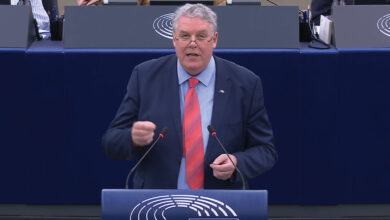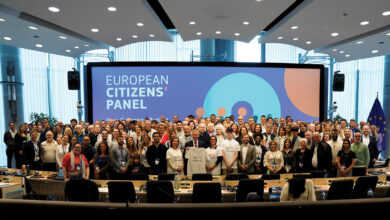Green stimulus: Aligning economic recovery and climate action

 The opportunity for Ireland to pursue a green stimulus post-pandemic is both significant and achievable but the window of opportunity is small. Brian Ó Gallachóir, Director of MaREI the SFI research centre for energy, climate and marine research, writes.
The opportunity for Ireland to pursue a green stimulus post-pandemic is both significant and achievable but the window of opportunity is small. Brian Ó Gallachóir, Director of MaREI the SFI research centre for energy, climate and marine research, writes.
Three distinct and unprecedented processes are happening in parallel. Firstly, in our battle against the coronavirus pandemic, public funds are being used in Ireland to subsidise salaries, the State is controlling private hospitals and citizens are staying at home and practicing social distancing. Secondly, our two political parties that were divided by the civil war nearly 100 years ago have agreed a framework to form a coalition government. Thirdly, the European Commission is proposing a €750 million Next Generation EU recovery plan. I don’t think anyone would have imagined any of these three developments six months ago, let alone all three happening together
What are the implications for climate action?
The scale of the coronavirus response from the Government and particularly from the public shows the significant capacity for transformative change that has been dormant and untapped. The climate change crisis is very different but there are clear parallels in terms of the scale of response and the need for innovative politics and societal buy-in is common to both.
Part of the government formation discussions are on climate action. The Government’s Climate Action Plan targets an average annual reduction in greenhouse gas emissions of 3.5 per cent per annum between now and 2030. The Green Party is seeking this ambition to be increased to 7 per cent per annum and has made this a red-line government formation issue.
While the EU is discussing the recovery plan, the European Green Deal, a plan for the EU to become carbon neutral by 2050 is also a core focus. European Commission President Ursula von der Leyen introduced Next Generation EU saying: “The recovery plan turns the immense challenge we face into an opportunity, not only by supporting the recovery but also by investing in our future: the European Green Deal and digitalization will boost jobs and growth, the resilience of our societies and the health of our environment. This is Europe’s moment.”
How can economic stimulus and climate action be aligned?
Here are my top seven suggestions for economic stimulus measures that can be used to form a key part of Ireland’s recovery while also increasing Ireland’s capacity for climate action.
1) A grant support and soft loan retrofit scheme for building owners and 2) a fully funded deep retrofit programme for local authorities.
Improving the insulation and heating systems in our homes and non-residential buildings can have significant benefits in terms of reducing fuel bills, improving the health and well-being of families and providing employment opportunities while also reducing greenhouse gas emissions. This measure will provide the necessary impetus for home owners and landlords to invest. The local authority programme will have an additional benefit of also addressing energy poverty.
3) A community development fund for communities to develop and deliver climate action projects.
The scale of the climate challenge requires a significant investment programme across all sectors of society. One critical but too often neglected aspect of this is the need to increase the societal capacity required for climate action. Recent research by the MaREI Centre has demonstrated that much needed supports are emerging to provide technical supports but the core funding necessary for the groups to recruit the community development expertise is lacking, despite being essential for these projects to progress. It is important that the approaches to support community energy should be developed that respond to the varied capacities of different communities
4) Infrastructural investment
Public and private investment in infrastructure to enable low carbon technologies will provide short term employment benefits and enable a long term return in enabling climate action. Infrastructure investment should initially focus on electric vehicle charging infrastructure, upgrading the electricity network to accommodate increased wind and solar energy and renewable gas injection facilities into the gas network. Infrastructure plans related to renewable diesel and hydrogen should also be developed and implemented.
5) Increased research funding
A significant increase in research funding is required, focusing on the largely neglected societal aspects of the energy transition, as well as the technology and engineering aspects. We also need a better understanding on the necessary business models and policy measures. The urgency surrounding climate action is growing, but the barriers and system inertia to change remain evident and strong.
“The scale of the coronavirus response from the Government and particularly from the public shows the significant capacity for transformative change that has been dormant and untapped.”
6) Remote working
Encouraging more remote working is a low cost measure that will reduce emissions, reduce traffic congestion and deliver improved physical and mental health benefits. We can build on the learnings gained during the pandemic. There are nearly 250,000 commuters, whose distance from work is more than 25km. Further beneficial initiatives in transport include increased investment in public transport and cycling and walking. Record numbers of bicycle sales have been recorded in Ireland during the pandemic and it is important to respond to this public statement with sufficient and safe cycling lanes and other infrastructure.
7) ‘Staycations’
Another stimulus could focus on encouraging Irish families to holiday at home, economically supporting the badly hit tourism sector, while also reducing emissions associated with air travel.
8) Flagship climate action projects
Supporting flagship climate action projects can be structured around research, business, administration and civil society jointly developing transition plans, monitoring the transition, developing policy responses and co-producing integrated solutions tailored to the local situation. Some of the benefits include local capacity building, providing the evidence base, monitoring the transition and developing adequate policy responses.
Areas such as the midlands, where there is a dependence on peat harvesting, parts of cities with energy inefficient buildings, or rural areas with intensive agriculture can point to where these flagship transition projects should be focused. This approach aligns well with the goal to align climate action with social justice. They can draw on existing targeted transition initiatives in Ireland such as the Dingle Peninsula 2030 project, where concentrated energy efficiency and renewable energy efforts are underway.
Many further green stimulus options in addition to these are required to address the climate crisis. The opportunity is large at this time but the window of opportunity is small. Our experience from previous disruptions tells us that the time for corrective action after a disruption is limited as social memory of the event fades, political priorities readjust and old habits resume.





